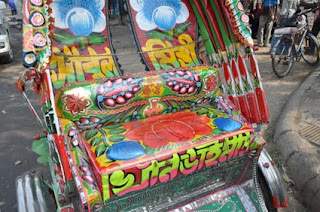First stop was Ahmed Hossainis house - a famous rickshaw painter.
Whilst much of a rickshaw is covered in decoration the most important bit, for the artwork, is the panel at the rear, under the seat and between the two rear wheels.
Printed panel:
Old printed panel:
Rickshaws only arrived in Bangladesh as recently as the 1960's and they are a key part of the transport system both in the cities and the rural areas.
Many of the rickshaws are owned by individuals who rent them out to the rickshaw 'drivers'.
A good quality rickshaw with bright and shiny paintwork and accessories will cost more for the driver to rent than one that looks more tired.
Much of the imagery used on the rickshaws is drawn from religion, mythology, birds and animals, film and tv stars (often with guns).
In the 70's some of the imagery became too risque for the authorities and figurative imagery was banned.
The panels use enamel paint on tin-plated steel sheet. Some modern panels are screen printed which is cheaper than the hand painted, some use gairishly bright pinks and yellows - which unfortunately arent UV stable and dont last long in the bright sunlight.
The panels are now sold as artworks for around 3500tk ( £35) and few of Ahmeds pieces now reach the rear of a rickshaw. Ahmed has applied his skills to several projects including calendars for the German embassy in Dhaka.
Tourists can commission pieces too. Supply him with portrait photos and he will put an image of you onto a rickshaw panel. You can be painted with your favorite pet, a submachine gun or even both!
There is a large industry focused around the cycle rickshaw, from their production, to their repair and restoration. It would cost in the region of £1500 to buy all the components and to build a rickshaw.
The seat is made from timber then clad in metal.
Sometimes these are painted. I particularly liked the nailwork, where dome- headed nails are used to create decorative details.

Reinforced cycle frames.
Sheet metal for covering the wood.
The forged rear wheel system.
Suspension and rear bumper bars.
Bamboo hoops for the hood.
Upholstery and stitched plastic panels for the hood.












































